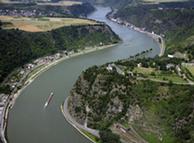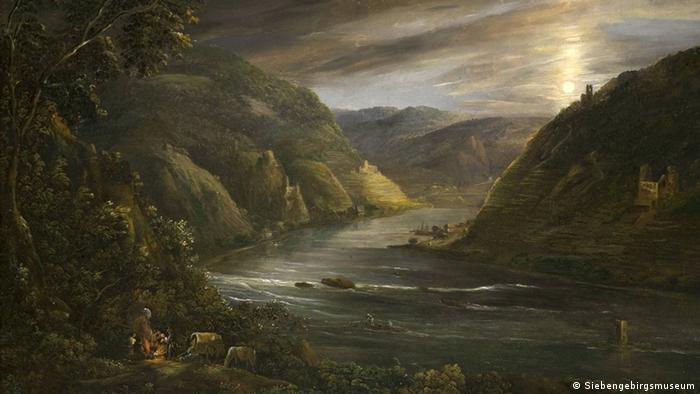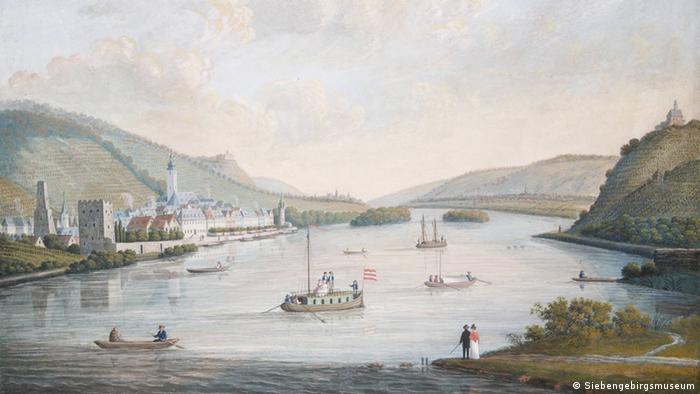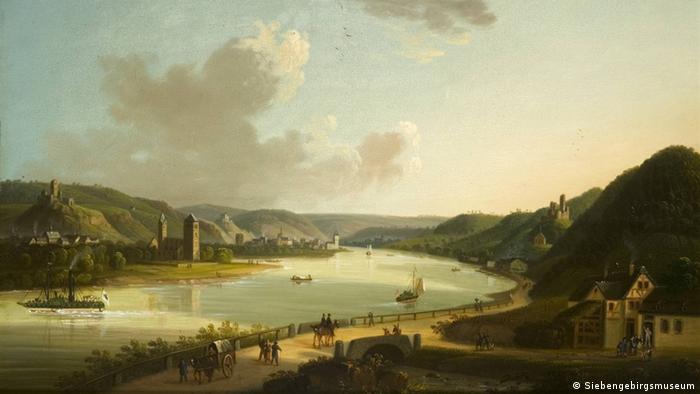一周点评:欧洲重新展开对核能的讨论
The Rhine is one of the most important rivers in Europe.
| |
| Wikimedia Commons: Rhine |
能源、核電、電力、熱能, 這是上週歐洲關注的焦點。由於日本福島核電站發生的災難,一些歐洲國家對核能的替代方案展開激烈的爭論。還有一些國家根本就沒有討論。雙方之間是多麼的不同,看一看歐洲最長的河流萊茵河就一目了然。這條河流構成了德國和法國之間一段很長的邊界。法國是對核電依賴程度最高的國家。該國大約80%的電能來自核電站,其核電比例之高居世界首位。而在德國,其公民歷來反對核能。德國的核能只佔全部電力供應的25%。
上週末,德國總理默克爾的保守黨在一次重要的地區選舉中遭受失敗,原因就是因為公民反對核能。他們不想讓保守黨重新恢復核電站的運營或者延長老核電站的使用期。德國綠黨在地區選舉中因此勝出。大約30年前綠黨成立的初衷就是抵制核電站。在德國,反核能運動全面發展。
與此同時,萊茵河彼岸的法國則認為核電站絕對安全。在法國的費森海姆,那裡有歐洲最古老的核電站,但是當地沒有人對核電站提出抗議和批評。
****
2010/12/29 收到Justing 寄來的 萊茵河
出自維基百科,自由嘅百科全書
萊茵河(德文:Rhein,瑞士德文:Rhy,法文:Rhin,荷蘭文:Rijn,羅曼什文:Rein)係歐洲第四長嘅河,有1230公里,短過伏加河、多瑙河同聶伯河。萊茵河由瑞士阿爾卑斯山區開始流,經列支敦士登、奧地利、德國、法國,最後去到荷蘭流入北海。
English
《莱茵河——历史、神话和现实》

[法]吕西安·费弗尔著
许明龙编译
辽宁教育出版社2003年1月出版,185千字。
目 录译序 超时代的真知灼见
——吕西安·费弗尔的《莱茵河》一书的价值…………………………郭华榕 1
告读者……………………………………………………………………………… 15
1935年版序言……………………………………………………………………… 17
第一章 莱茵河的三个题目……………………………………………………… 1
Ⅰ.“通道”一条大河的形成……………………………………………………… 2
Ⅱ.天然边界……………………………………………………………………… 12
Ⅲ.两个种族之间的莱茵河……………………………………………………… 20
第二章 三个形象,三种酵母…………………………………………………… 34
Ⅰ.罗马化地区…………………………………………………………………… 34
Ⅱ.蛮族…………………………………………………………………………… 52
Ⅲ.教会…………………………………………………………………………… 79
第三章 从城邦到国家…………………………………………………………… 98
Ⅰ.莱茵河城市…………………………………………………………………… 98
Ⅱ.从城市到君主…………………………………………………………………136
Ⅲ.走向两个民族间的莱茵河……………………………………………………156
第四章 一条边界是如何形成和消失的…………………………………………177
Ⅰ.莱茵河:从法国的界河到法兰西帝国的流域………………………………177
Ⅱ.莱茵河:从德意志的界河到德国的河流……………………………………189
结束语:回眸往昔………………………………………………………………204
附录………………………………………………………………………………208
Ⅰ.第一版(1931年)结束语………………………………………………………208
Ⅱ.关于莱茵河经济史的若干思考(1953年)……………………………………212
Ⅲ.皮特·舍特勒拟定的补充书目…………………………………………………222
参考书目……………………………………………………………………………239
In 2002 the Upper Middle Rhine Valley was named a World Heritage site.
The Rhine's real heydey, however, was 200 years ago when the
Romanticists first discovered the river and made it their muse.
English poet Lord Byron was so enraptured by the ruins on the
Drachenfels mountain in 1816 that he immediately reached for his pen and
wrote the famous lines of "The Castled Crag of Drachenfels."
Byron wrote with fervor that he would like to spend the rest of his life at the foot of the tower-crowned mountain. His verses sparked an avalanche of nature-inspired poetry and also kicked the Rhine tourism industry into gear.
The region is known as Siebengebirge or Seven Mountains. Today, the Siebengebirgsmuseum in the sleepy town of Königswinter near Bonn illuminates the Romanticists' fascination with Germany's most famous river. The exhibition hall is in just the right place: When visitors exit the train, they see the Drachenfels mountain and the Drachenburg castle looming majestically in the sky.
Painters' muse
The area on the Rhine is a popular tourist destination that is mentioned in every guidebook. Not only poets like Heinrich Heine, Clemens Brentano or Joseph von Eichendorf visited the region, but numerous painters also ventured here to interpret the landscape with their brushes.
"The mix of this region fascinated artists," said the museum's director, Elmar Schueren, "On the one hand, it was the scenery that lends itself beautifully to being painted, and on the other hand, it was the activity of the people."
Castles on the left and the right of the Rhine were witness to this activity. During the Middle Ages they were built as obsolete. New weapons techniques made them superfluous and, built for battle, they didn't make suitable residences.
It's amazing that any are left standing at all, said Scheuren, because some were used as stone quarries for the construction of churches. Even the stones of the Cologne Cathedral stem from the Rhine. Up until the 19th century, the gray stone of Drachenfels was dismantled and shipped to Cologne.
The other landscape
For the Romanticists the ruins along the Rhine provided just the right amount of eerie inspiration they needed for their art. Their works also became political symbols of a growing national sentiment in the 19th century.
While the wild and untouched nature inspired the artists, signs of civilization and progress also surfaced in their art. Johannes Jakob Diezler crafted the painting "Niederlahnstein and Kappellen-Stozenfels" in 1830, portraying a perfect idyll - but only at first glance.
Upon closer examination, you'll see that the artist wasn't only interested in beautiful scenery, but that the painting also depicts modern infrastructure. A steamboat glides through the Rhine; a vineyard dots the riverbanks; a carriage brings travelers to the river.
"The cultural landscape was, for them, the landscape," explained Scheuren.
Birth of the Lorelei
The Romanticists had plenty of imagination; they exaggerated the landscapes they saw and projected their own fantasies into them. One result was the legend of the Lorelei.
Prior to the 19th century, the Lorelei was nothing more than a slate rock at St. Goarshausen near Koblenz. Due to shallow spots in the channel, the passage was dangerous, and a number of shipwrecks occurred.
The legend of a mystical mermaid, who sat on the rock, combing her golden hair and casting sailors under her spell of song, can be traced back to the year 1801.
In his ballad, "In Bacharach on the Rhine," Clemens Bentano described an enchantress in the village. At this time, the rock played no role. It wasn't until the 1820s that Heinrich Heine revisited the story and placed the hair-combing enchantress from Bacharach on the stone.
"As such, the legend was perfect," said Scheuren, adding that the story of Siegfried the dragon slayer came about in a similar manner.
"The dragon fight was pure fiction," he said. "The story first appeared in the 18th century. The debate ran for a few years; then it became a legend that continues today."
Landscape of memories
What didn't exist was quickly invented. The Rhine depictions by Swiss painter Ludwig Bleueler demonstrate a contradiction between dream and reality. One of his pictures of Mainz shows a park with people milling about and a locomotive passing through.
"At that point the railway on the left side of the Rhine was only in the planning stages," said Scheuren. "When it was opened, Bleueler had been dead for three years."
The ongoing spread of technology didn't just change the portraits of the Rhine. At the end of the 1820s, thousands of tourists flocked to the region. The exclusive production of photos gave way to mass consumption.
Steamboats began offering affordable travel, and even members of the British royal family - attracted perhaps by the verses of their national poet Lord Byron - visited the acclaimed river.
The popularity of Rhine artwork peaked at the end of the 19th century. In the 20th century, long-distance travel replaced vacationing on the Rhine. Nevertheless, the beloved river has not been forgotten. At 350 meters, Drachenfels is allegedly the most-climbed mountain in Europe.
Byron wrote with fervor that he would like to spend the rest of his life at the foot of the tower-crowned mountain. His verses sparked an avalanche of nature-inspired poetry and also kicked the Rhine tourism industry into gear.
The region is known as Siebengebirge or Seven Mountains. Today, the Siebengebirgsmuseum in the sleepy town of Königswinter near Bonn illuminates the Romanticists' fascination with Germany's most famous river. The exhibition hall is in just the right place: When visitors exit the train, they see the Drachenfels mountain and the Drachenburg castle looming majestically in the sky.
Painters' muse
The area on the Rhine is a popular tourist destination that is mentioned in every guidebook. Not only poets like Heinrich Heine, Clemens Brentano or Joseph von Eichendorf visited the region, but numerous painters also ventured here to interpret the landscape with their brushes.
"The mix of this region fascinated artists," said the museum's director, Elmar Schueren, "On the one hand, it was the scenery that lends itself beautifully to being painted, and on the other hand, it was the activity of the people."
Castles on the left and the right of the Rhine were witness to this activity. During the Middle Ages they were built as obsolete. New weapons techniques made them superfluous and, built for battle, they didn't make suitable residences.
It's amazing that any are left standing at all, said Scheuren, because some were used as stone quarries for the construction of churches. Even the stones of the Cologne Cathedral stem from the Rhine. Up until the 19th century, the gray stone of Drachenfels was dismantled and shipped to Cologne.
The other landscape
For the Romanticists the ruins along the Rhine provided just the right amount of eerie inspiration they needed for their art. Their works also became political symbols of a growing national sentiment in the 19th century.
While the wild and untouched nature inspired the artists, signs of civilization and progress also surfaced in their art. Johannes Jakob Diezler crafted the painting "Niederlahnstein and Kappellen-Stozenfels" in 1830, portraying a perfect idyll - but only at first glance.
Upon closer examination, you'll see that the artist wasn't only interested in beautiful scenery, but that the painting also depicts modern infrastructure. A steamboat glides through the Rhine; a vineyard dots the riverbanks; a carriage brings travelers to the river.
"The cultural landscape was, for them, the landscape," explained Scheuren.
Birth of the Lorelei
The Romanticists had plenty of imagination; they exaggerated the landscapes they saw and projected their own fantasies into them. One result was the legend of the Lorelei.
Prior to the 19th century, the Lorelei was nothing more than a slate rock at St. Goarshausen near Koblenz. Due to shallow spots in the channel, the passage was dangerous, and a number of shipwrecks occurred.
The legend of a mystical mermaid, who sat on the rock, combing her golden hair and casting sailors under her spell of song, can be traced back to the year 1801.
In his ballad, "In Bacharach on the Rhine," Clemens Bentano described an enchantress in the village. At this time, the rock played no role. It wasn't until the 1820s that Heinrich Heine revisited the story and placed the hair-combing enchantress from Bacharach on the stone.
"As such, the legend was perfect," said Scheuren, adding that the story of Siegfried the dragon slayer came about in a similar manner.
"The dragon fight was pure fiction," he said. "The story first appeared in the 18th century. The debate ran for a few years; then it became a legend that continues today."
Landscape of memories
What didn't exist was quickly invented. The Rhine depictions by Swiss painter Ludwig Bleueler demonstrate a contradiction between dream and reality. One of his pictures of Mainz shows a park with people milling about and a locomotive passing through.
"At that point the railway on the left side of the Rhine was only in the planning stages," said Scheuren. "When it was opened, Bleueler had been dead for three years."
The ongoing spread of technology didn't just change the portraits of the Rhine. At the end of the 1820s, thousands of tourists flocked to the region. The exclusive production of photos gave way to mass consumption.
Steamboats began offering affordable travel, and even members of the British royal family - attracted perhaps by the verses of their national poet Lord Byron - visited the acclaimed river.
The popularity of Rhine artwork peaked at the end of the 19th century. In the 20th century, long-distance travel replaced vacationing on the Rhine. Nevertheless, the beloved river has not been forgotten. At 350 meters, Drachenfels is allegedly the most-climbed mountain in Europe.






沒有留言:
張貼留言